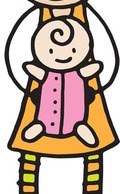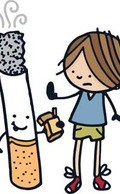Family Health: Dear Parent
Ruth Thomson
Monday, July 14, 2014
In a letter to all parents of young children, Dr Raj Thakkar offers some guidance on both common and more serious medical conditions, what symptoms to look out for, and how to treat them

Being a parent to a young child is not easy. Along with the challenges of nurturing, teaching and guiding, there are a host of medical questions that add to the complexity of bringing up a child.
All parents' concerns cannot be covered in this one letter; after all, paediatrics is a medical speciality in its own right. Here, however, I hope to provide you with essential advice on ten paediatric complaints - some common and some less common but more serious conditions that you need to be aware of.
My letter is a whistle-stop tour, but the messages are clear: a pragmatic approach is sensible, self-care is important, and always seek advice when your child is unwell.
1. NAPPY RASH
 Despite sounding trivial, and of course it may be, nappy rash can be painful for the child and leave parents feeling both anxious and guilty. Nappy rash affects around a third of children, most commonly infants of between nine and 12 months.
Despite sounding trivial, and of course it may be, nappy rash can be painful for the child and leave parents feeling both anxious and guilty. Nappy rash affects around a third of children, most commonly infants of between nine and 12 months.
Causes The most common cause is an 'irritant dermatitis', whereby the skin becomes inflamed after being exposed to urine or faeces for a long time.
Infrequent nappy changing, poorly absorbent nappies, excessive or harsh wiping and use of some soaps can increase the risk of a child getting nappy rash. Candida (a fungus) can also cause nappy rash, the hallmark of which are satellite lesions.
Both of these rashes can be complicated by a bacterial infection and ulceration. Other skin conditions that can cause nappy rash include impetigo, allergic dermatitis, perianal streptococcal dermatitis, seborrhoeic dermatitis, eczema and psoriasis, as well as rarer conditions such as zinc deficiency. (Zinc deficiency is most common in premature babies and, in addition to nappy rash, can cause a rash on the hands and around the mouth.)
Treatment - Use good-quality nappies, along with barrier cream, and change nappies regularly. Nappy rash caused by candida will require an anti-fungal cream. In more serious cases of nappy rash, antibiotics may be needed.
2. IMPETIGO
Impetigo affects about 3 per cent of oneto four-year-olds, and occurs more frequently in the summer months.
Causes - The most likely cause is group A streptococcus - a common bacteria that can also cause tonsillitis, ear infections, pneumonia and meningitis. However, it may also be caused by staphylococcus aureus, or a combination of these bacteria.
Children are at greater risk of developing impetigo if they have eczema or nappy rash or if the skin has been breached by a cut or bite. More aggressive impetigo can occur in children who have diabetes, leukaemia or other immune problems.
Symptoms - The classic symptom is a clearly defined and painless red lesion, usually around the nose or mouth.
It may be itchy and quickly develop a honeycomb-like yellow crust. Healing usually occurs without scarring, and fever is seldom a feature.
Treatment - For most children, impetigo is cured by the body's own defences, or with simple antibiotics. Occasionally, the bacteria can spread to the deeper layers of the skin, causing cellulitis, which is treated with antibiotics.
Affected children should wash their hands regularly and use separate towels to reduce the risk of spreading the condition to others.
Keeping the child at home until the impetigo stops weeping or for 48 hours after starting to take antibiotics will also help to prevent the condition spreading.
3. FEBRILE CONVULSIONS
A febrile convulsion is a childhood seizure or 'fit' that occurs when a child has a fever - suggesting an infection - but does not occur with diseases of the brain, such as meningitis. Most febrile convulsions occur between three months and five years of age.
Causes - Middle-ear infections, pneumonia, urinary tract infections, gut and viral infections such as influenza, roseola and croup can cause fever and hence may trigger a seizure.
Children are more likely to suffer a febrile convulsion if they have suffered one in the past or if there is a family history of them. Other risk factors include developmental abnormalities, illness requiring hospital admission for the first month of life and maternal smoking or alcohol use in pregnancy.
Types - 'Simple' febrile convulsions last for less than 15 minutes and occur no more than once over a 24-hour period. 'Complex' convulsions are more sinister and last longer than 15 minutes, may recur over a 24-hour period and can affect one side of the body more than another.
Treatment - In addition to emergency measures, doctors will aim to identify the source of infection and treat accordingly.
Paracetamol and ibuprofen may be used, but do not reduce the risk of convulsion. There is no evidence that antibiotics reduce the risk either. In most cases, the child experiences no long-term effects, although the risk of epilepsy rises from a 1 per cent background risk to 1.5-2 per cent.
See also: www.nhs.uk/conditions/ febrile-convulsions/pages/introduction.aspx
4. CROUP
Croup is, by and large, a viral infection of the larynx, trachea and sometimes its two branches -namely the principal bronchi. It is a disease of the upper airway and is distinct from bronchiolitis, which is a disease of the smaller airways.
It is principally a childhood disease, particularly affecting those between six months and three years of age. Boys are affected slightly more than girls and it is more common in winter.
Symptoms Typical features include fever, runny nose, hoarse voice and a classic 'barking' or 'seal-like' cough. Croup should be distinguished from other conditions affecting the upper airway such as epiglottitis, abscess or a foreign body.
Treatment While most cases of croup are mild, more severe cases may cause varying degrees of upper airways obstruction (stridor), which may need oral steroid therapy or even adrenaline, administered via a nebuliser or tube.
Complications include throat abscesses, ear infections, pneumonia, an air 'leak' in the lining of the lung (pneumothorax), febrile convulsions and even death.
There is little medical evidence to support the use of steam or mist therapy in croup. However, exposure to cool air relieves symptoms significantly, presumably by reducing the swelling in the upper airway - similar to putting an ice pack on a swollen bruise.
5. ASTHMA
 Asthma is an inflammatory disease of the small airways - unlike croup, which is a disease of the upper or large airways. The hallmark of asthma is bronchospasm, when the small airways contract, causing 'reversible airways obstruction' resulting in cough, wheeze and breathlessness.
Asthma is an inflammatory disease of the small airways - unlike croup, which is a disease of the upper or large airways. The hallmark of asthma is bronchospasm, when the small airways contract, causing 'reversible airways obstruction' resulting in cough, wheeze and breathlessness.
Note, however, there are several other causes of wheeze in addition to asthma including infection, allergy and some prescribed drugs. Risk factors for developing asthma include a personal or family history of atopic diseases, namely asthma, eczema or hayfever.
Triggers and symptoms Asthmatic symptoms tend to be worse at night because the airways tend to be narrower at nighttime. This means symptoms vary over the 24-hour cycle.
Typical asthmatic triggers include infection, allergy, cold weather, exercise and cigarette smoke, which increases the risk of hospital admission significantly.
While infection can make asthma worse, wheeze that occurs only when a child has an infection is not likely to be asthma.
Complications of asthma include an 'attack' where the airways are narrowed such that sleep is disturbed, eating or drinking is interrupted by the need to breathe or there is breathlessness with little or no exertion. Infection and a pneumothorax can also be caused by asthma.
Treatment Asthma accounts for more than 1,000 deaths per year in the UK, many of which are preventable by ensuring affected people take their treatment as prescribed and avoid being exposed to cigarette smoke.
The mainstay of treatment, except for very mild cases, is inhaled steroids that reduce the inflammation within the airways.
As is so often the case in medicine, failure to take medicines as prescribed and poor self-care is very common and can lead to serious complications.
6. BEDWETTING
One of the most common conditions that can affect a child is bedwetting. From the outside, it can sound rather trivial; however, the impact on the child and family can be all-consuming. It affects 10 per cent of five-year-olds and 5 per cent of ten-year-olds, and is more common in boys.
Causes Very seldom is there an underlying cause for concern. Nevertheless, there are some exceptions. Distress, urine infections, diabetes, constipation or fizzy drinks may cause bedwetting and daytime incontinence in previously dry children. Rarer, more sinister, causes also exist and children who develop bedwetting after being dry should always be reviewed by a doctor.
Treatment For most children who have never achieved continence, reassurance, education, support and patience are all that is needed for nighttime dryness.
Simple measures such as sticker reward charts, leaving the bathroom light on or using a wetting alarm may offer remarkable success. It is important to avoid putting undue pressure on the child. Avoiding caffeinated drinks and ensuring the child goes to the toilet before going to bed is sensible. Restricting water is not recommended as the bladder may fail to learn to recognise that it is full and dehydration increases the risk of constipation.
Some advocate waking the child and taking them to the toilet rather than risk bedwetting. However, this does not allow the neurological system to develop and wake the child automatically when the bladder is full.
Nevertheless, taking the child to the toilet if they are already awake is recommended. In some cases, medications may be used in the short term.
7. CONSTIPATION
Constipation is a common condition, can cause urinary tract infections and lead to incontinence. It can affect up to a third of children and is often distressing for the child and family alike.
Causes There are several factors that lead to constipation and a single cause isn't always identified. Change or introduction of formula feed, changes in diet, dehydration and stool holding are common causes, whereas conditions such as thyroid disorders, Hirschsprung's disease, cystic fibrosis, cerebral palsy and spina bifida are rare but should be borne in mind.
Treatment Treatment varies but methods are aimed at identifying and treating underlying causes, ensuring hydration, using laxatives or changing the child's diet to empty the bowel and keep motions regular, and managing any behavioural problems.
Complications can include over-stretching of the rectum, which loses its muscle tone. Patients who suffer from this may require regular enemas under anaesthetic.
See also: www.nhs.uk/conditions/constipation/pages/introduction.aspx
8. MENINGITIS
Without doubt, meningitis is frightening and potentially devastating, but with education, parents can improve outcomes enormously.
Meningitis is inflammation of the covering of the brain and spinal cord, known as the meninges.
Causes It is usually caused by infection, bacterial being more serious than viruses on the whole. The key messages here are about recognising the condition and seeking help early.
Symptoms It is a commonly held belief that a diagnosis of meningitis can only be made if a child has a rash and conversely that if a child doesn't have a rash, they do not have meningitis. Both of these statements are untrue.
The classic rash of meningitis is known as a 'purpuric rash', which doesn't disappear under pressure and is caused by bleeding within the skin. It is in fact indicative of meningococcal septicaemia (blood poisoning) rather than meningitis per se. Not all patients with meningitis will have septicaemia and hence not all will have a rash. Of those that do, it often appears in the latter stages of the illness when it may be too late for treatment to be effective.
In the early stages of the disease, children may present with a variety of seemingly trivial or vague symptoms such as feeling generally unwell, fever, nausea or vomiting, abdominal pain, diarrhoea and a cough.
Some children may then begin to complain of leg pain. By this stage, they may also have cool hands and feet, complain of a headache and that the light hurts their eyes (known as photophobia). Once the disease is fully established, the child may have a stiff neck.
Babies may appear vacant, breathless, have a high-pitched cry, or merely be irritable and off their food.
The soft spot on a baby's head, known as the fontanelle, may be tense or even bulge once meningitis has taken hold.
The message here is a simple one: the rash occurs late in meningococcal disease and the absence of a rash should not reassure. If you suspect a child has a serious illness it is crucial to seek medical help early.
See also: www.nhs.uk/conditions/meningitis/pages/introduction.aspx
9. OBESITY
 Self-care is crucial in all aspects of a child's health and obesity is a good example of something that needs addressing on a national scale.
Self-care is crucial in all aspects of a child's health and obesity is a good example of something that needs addressing on a national scale.
There is a childhood obesity epidemic and unless something is done quickly the consequences will be dire.
For the nation, it will result in escalating health and social costs in an era where the NHS has been mandated to save more than £20bn over the next five years and the welfare state is already underfunded.
If a child is obese early in their second decade of life, they are likely to remain obese into adulthood.
By age 10, early cholesterol deposits in the coronary arteries can be identified. In adulthood, obesity not only increases the risks of cardiovascular disease, diabetes and arthritis, but also significantly increases the risk of cancer.
Families need to ensure their children enjoy a balanced and healthy diet and have lots of opportunity to play and run around outdoors if we are to avert an obesity time bomb.
See also: www.nhs.uk/conditions/obesity/pages/introduction.aspx
10. VITAMIN D DEFICIENCY
 Vitamin D is a fat-soluble vitamin that requires both the liver and the kidney to activate it. It is manufactured in the skin in the presence of ultraviolet B (UVB) rays - namely sunshine - and is needed for healthy bones and hence essential for growth. While sunshine is the main source of vitamin D, it is also found in some foods such as oily fish and eggs.
Vitamin D is a fat-soluble vitamin that requires both the liver and the kidney to activate it. It is manufactured in the skin in the presence of ultraviolet B (UVB) rays - namely sunshine - and is needed for healthy bones and hence essential for growth. While sunshine is the main source of vitamin D, it is also found in some foods such as oily fish and eggs.
Deficiency is common in the UK as there is a lack of UVB between October and April. Children with darker skin are even more susceptible. Deficiency can cause cramps, weakness, rickets associated with low calcium, bowed-legs, bone pain, poor growth, and even heart failure and seizures.
As such, it is now recommended that pregnant women, breastfeeding women and infants from six months to five years old should take vitamin D supplements. Infants on formula may receive enough vitamin D, depending on the levels that they consume. Parents should ensure their children enjoy playing outdoors, but be mindful of the risk of sunburn.
 Dr Raj Thakkar BSc (Hons) MBBS MRCGP MRCP (UK) is a GP, commissioning director and author of the MIMS Consultation Guide and MIMS diagnosis and management app.
Dr Raj Thakkar BSc (Hons) MBBS MRCGP MRCP (UK) is a GP, commissioning director and author of the MIMS Consultation Guide and MIMS diagnosis and management app.




